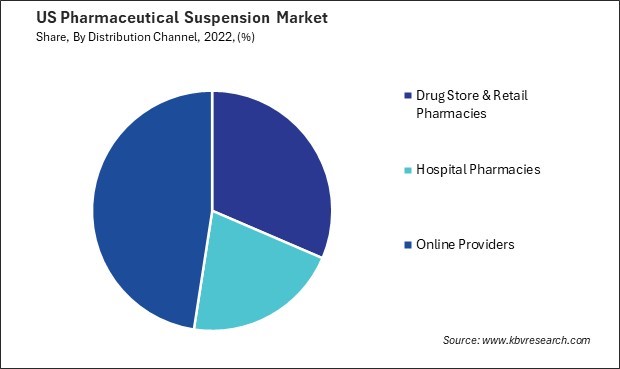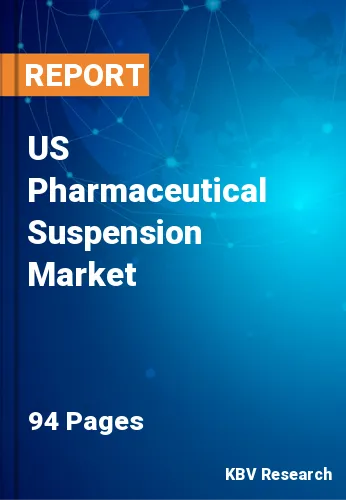The United States (US) Pharmaceutical Suspension Market size is expected to reach $18.5 Billion by 2030, rising at a market growth of 2.6% CAGR during the forecast period.
The pharmaceutical suspension market in the United States is a dynamic and integral component of the nation's healthcare industry. One key driver of the pharmaceutical suspension market in the U.S. is the growing demand for pediatric and geriatric formulations. Children and older adults often face challenges swallowing traditional solid dosage forms, making liquid suspensions an essential alternative. Furthermore, the pharmaceutical suspension market in the U.S. is characterized by a wide range of therapeutic applications. Various pharmaceutical companies develop suspensions for medications targeting diverse therapeutic areas, including antibiotics, antipyretics, analgesics, and anti-inflammatory drugs.

Regulatory factors also shape the pharmaceutical suspension landscape in the U.S. The stringent regulatory framework ensures that these formulations adhere to safety, efficacy, and quality standards. The U.S. Food and Drug Administration (FDA) plays a pivotal role in overseeing the approval and commercialization of pharmaceutical suspensions, ensuring that patients receive reliable and effective medications.
The COVID-19 pandemic has had a profound impact on the pharmaceutical industry, including the pharmaceutical suspension market in the U.S. The pandemic disrupted global supply chains, leading to shortages of raw materials and delaying manufacturing processes. Lockdowns, travel restrictions, and prioritization of resources for COVID-19-related activities also affected the production and distribution of pharmaceutical suspensions.
Moreover, the increased demand for certain medications during the pandemic, coupled with supply chain challenges, led to product availability and pricing fluctuations. The pharmaceutical suspension market had to adapt to these unprecedented challenges, with companies implementing strategies such as diversifying suppliers, optimizing production processes, and enhancing digitalization to ensure business continuity.
The pharmaceutical suspension market in the United States is experiencing a significant impact due to the growing prevalence of chronic diseases. One of the primary reasons for the surge in chronic diseases is the aging population. As the baby boomer generation enters older age, the incidence of chronic conditions tends to rise. Additionally, lifestyle factors such as sedentary habits, poor dietary choices, and high stress levels contribute to the increasing burden of chronic diseases in the U.S.
Pharmaceutical suspensions play a crucial role in treating and managing chronic conditions. These suspensions often provide a more convenient and patient-friendly form of medication, especially for Americans who have difficulty swallowing pills or prefer liquid formulations. Conditions like obesity and cardiovascular diseases necessitate long-term medication, and pharmaceutical suspensions offer an effective and convenient way to administer these drugs.
Furthermore, the pharmaceutical industry continuously innovates to develop advanced formulations and delivery systems within the suspension category. These innovations aim to improve the efficacy of treatments, reduce side effects, and enhance patient compliance. For example, extended-release suspensions provide a sustained release of medications, allowing for less frequent dosing and better disease management. Thus, the increasing prevalence of chronic diseases, driven by factors like an aging population and lifestyle choices, is significantly impacting the pharmaceutical suspension market in the United States.
The pharmaceutical suspension market in the United States is experiencing a notable shift in demand dynamics, with a distinct rise in the need for pediatric and geriatric formulations. In the case of pediatric formulations, there is a growing recognition of the importance of dosage forms that are palatable, easily administered, and tailored to the specific needs of children. Pediatric patients often face challenges swallowing conventional tablets or capsules, leading to a preference for liquid formulations like suspensions. U.S. pharmaceutical companies are investing in research and development to create pediatric-friendly suspensions with accurate dosing, improved taste profiles, and enhanced safety.
On the other end of the age spectrum, the senior population presents challenges in medication administration. According to the United States Census Bureau, the older population expanded by 50.9 million, from 4.9 million in 1920 to 55.8 million in 2020. Elderly individuals in the U.S. is experiencing difficulties in swallowing, reduced gastric acid secretion, and altered drug metabolism. Pharmaceutical suspensions offer a viable solution by providing easy swallowing and improved bioavailability, ensuring that elderly U.S. patients receive the intended therapeutic benefits.
Additionally, advancements in formulation technologies, taste-masking techniques, and the availability of a diverse range of active pharmaceutical ingredients contribute to the expansion of the pediatric and geriatric pharmaceutical suspension market in the U.S. Pharmaceutical companies are actively collaborating with healthcare professionals to address the specific needs of these age groups, ensuring that medication delivery is both effective and well-tolerated. Hence, the pharmaceutical suspension market in the United States is witnessing a shift towards meeting the unique demands of pediatric and geriatric populations, focusing on palatable and easily administered formulations.

The pharmaceutical suspension market in the United States is a dynamic and crucial sector within the broader pharmaceutical industry. Several companies play a significant role in shaping and contributing to the growth of the pharmaceutical suspension market in the U.S. One notable player in this industry is Johnson & Johnson, a multinational pharmaceutical and consumer goods company. Johnson & Johnson has a strong presence in the U.S. pharmaceutical industry, offering diverse products, including pharmaceutical suspensions. The company's commitment to innovation and research and development has positioned it as a key player in addressing various medical needs through effective drug delivery systems.
Mylan N.V. is also a significant player in the U.S. pharmaceutical suspension market. The company focuses on developing and manufacturing various pharmaceutical formulations, including suspensions. Mylan's commitment to providing high-quality and affordable medications has established it as a key participant in the pharmaceutical industry, meeting the evolving needs of patients and healthcare professionals.
Another major contributor is Pfizer Inc., a global pharmaceutical giant with a robust portfolio of pharmaceutical products, including suspensions. Pfizer's involvement in the U.S. pharmaceutical suspension market is driven by its dedication to advancing healthcare solutions. The company's diverse product offerings cater to a wide range of therapeutic areas, contributing to its prominence in the pharmaceutical sector.
In recent years, emerging companies such as Amneal Pharmaceuticals have gained traction in the U.S. pharmaceutical suspension market. Amneal Pharmaceuticals focuses on developing and manufacturing complex generic and specialty pharmaceuticals, contributing to the country's growing landscape of pharmaceutical suspensions. The company's emphasis on research and development ensures a steady pipeline of innovative products to address diverse medical challenges.
Teva Pharmaceutical Industries is another notable player in the U.S. pharmaceutical suspension market. As one of the largest generic pharmaceutical manufacturers globally, Teva is crucial in providing affordable and accessible healthcare solutions, including a range of pharmaceutical suspensions. These companies contribute to developing, manufacturing, and distributing pharmaceutical suspensions, playing a vital role in ensuring the availability of effective and diverse drug delivery options for patients in the United States. The industry's continuous focus on research and development, innovation, and addressing therapeutic gaps underscores its significance in the broader pharmaceutical landscape.
By Type
By Distribution Channel
By End User
By Indication
Our team of dedicated experts can provide you with attractive expansion opportunities for your business.

